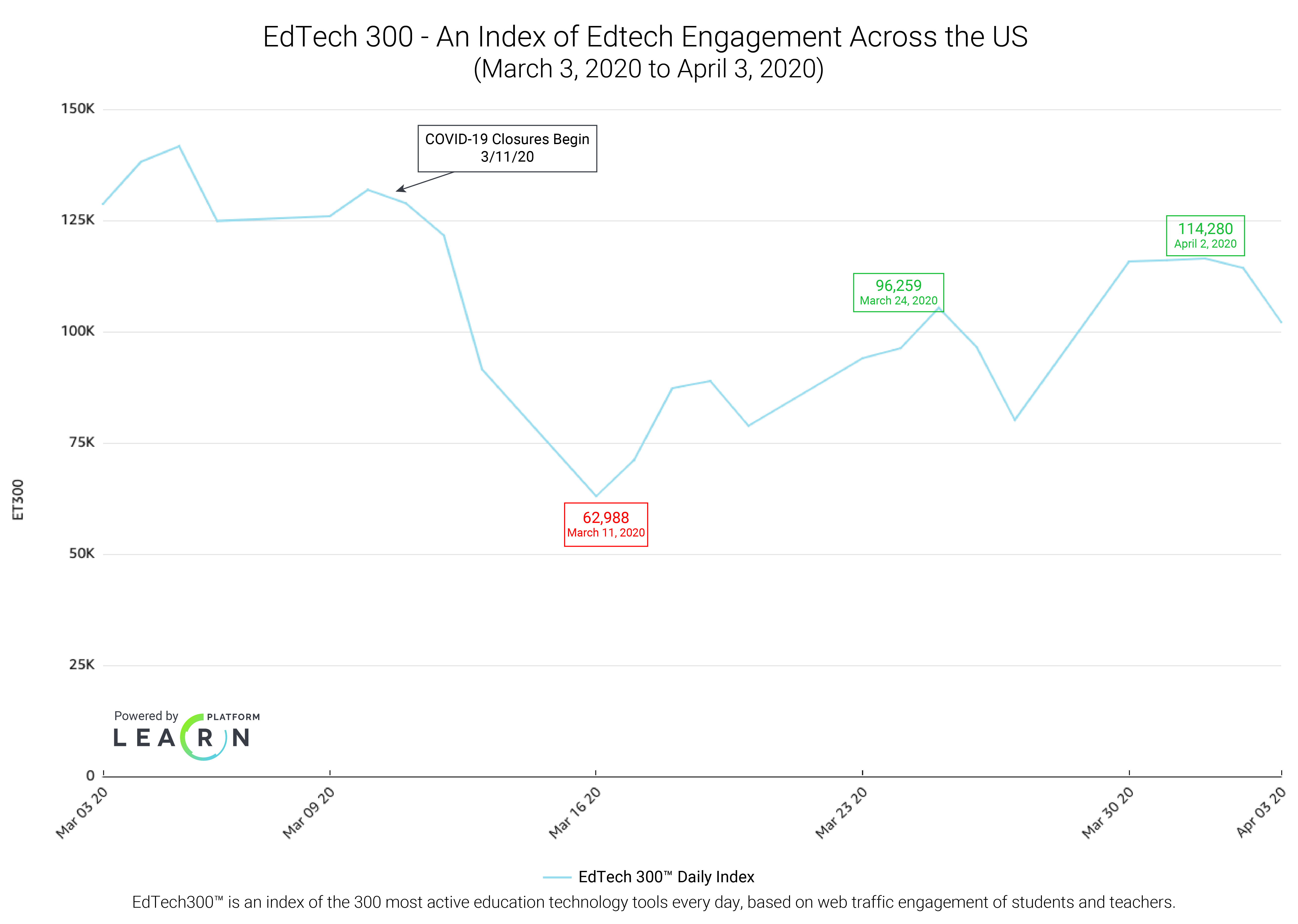
When school districts began closing in mid-March, education-technology usage dropped over 60 percent in the first week. After that initial drop, usage has increased steadily, but with an alarming set of trends. According to an analysis of 2 million students and teachers throughout the United States, fewer students have been accessing education technology, but those who have been are accessing it 40 percent more often than they were prior to closure of schools. In other words, those who are using education technology are using it more, while those who are not are getting left behind. This is the very definition of an expanding digital divide.

|
Date |
ET300™ |
Change |
|
March 5, 2020 |
141,668 |
– |
|
March 11, 2020 |
128,850 |
– 12,818 |
|
March 16, 2020 |
62,988 |
– 65,862 |
|
March 24, 2020 |
96,259 |
+ 33,271 |
|
April 2, 2020 |
114,280 |
+ 18,021 |
The EdTech300 is an index of daily web engagement of the 300 most active education-technology tools every day, accounting for both pervasiveness and amount of engagement by active users. The ET300 is calculated by LearnPlatform, based on the average number of events per 1000 active users, across over 2 million students and teachers in the US.
Source: LearnPlatform, US ET300. Click for full report.
While many districts have distributed laptops and Wi-Fi hot spots, access is only the first step. Remote-learning plans that support engagement and effectiveness will define equity (or lack thereof). A deeper look into the data shows differing—and sometimes disturbing—patterns in student and teacher engagement with education technology in different geographies. Policies and investments in safe and cost-effective technology ecosystems are leading some states to bounce back more quickly for more of their students, while others appear to be digging a deeper hole. The patterns in certain states and districts point to three key steps states should take to ensure equitable implementation of education technology.
1. Invest in Engagement and Effectiveness, Not Just Access
The need for a device and connectivity is table-stakes for pervasive access, and groups urging federal flexibility for programs like the US Department of Education’s Title programs are well-supported by the data. Going beyond access to support broad engagement should be the priority, however.
Utah has been investing in effective “fidelity” of education-technology use for the past five years, and the trends show a rapid, relatively smooth transition to remote learning when compared to other states. Utah’s Digital Teaching and Learning Initiative has focused on core-subject instructional technologies, professional development, and local control for decisions about how often tools are used with different groups to reach the best outcomes. With policies and regulations to equip local and state leaders with the data to make ongoing decisions, the state shows early positive signs.
2. Lower Costs and Make Access Safer by Centralizing Student-Data Privacy Management
With the rapid acceleration to online and remote learning, it is essential that states and districts ensure their technology tools comply with federal regulations and state laws related to student-data privacy. Thirty-eight states have enacted stringent regulations for privacy in the past four years, but the onus (and cost) of ensuring compliance with federal and state requirements, keeping track of products’ ever-changing privacy policies, communicating with parents, and safeguarding students’ personally identifiable information is borne by local education agencies.
Connecticut, which passed one of the earliest and most stringent privacy regulations in the country four years ago, centralized their statewide student-data privacy clearinghouse after district administrators bemoaned the redundant privacy vetting each district was required to complete. In the last two years, providers have been able to share privacy policies and ensure compliance in a single location, and administrators see this information centrally, eliminating millions of dollars of staff time taken by having to repeat the same steps in each district. Through an executive order by the governor in mid-March, Connecticut quickly leveraged the system to further streamline requirements, and, in the interest of rapid recovery, gave local officials and educators confidence in the growing list of approved tools for their remote learning plans. Now, Connecticut is close to reaching previous levels of access and engagement, while other states’ levels remain flat or are rising slowly.
3. Increase Purchasing Power with Cooperative, Small-Batch Purchasing
Cost-effective decision-making will be key to ensure individual students get what they need to succeed. In the 2018–19 school year, over $1 billion was paid for education-technology licenses that were never used. As the economy slows down, and state and local budgets begin to fall short, a purchasing-mindset shift from “everybody gets one” to “everybody gets what they need” can save states tens of millions of dollars, especially in an environment of increased digital learning.
While many things are unknown in this evolving learning landscape, one thing is certain: policymakers that work together to support safe, equitable, and cost-effective infrastructure to support learning for all students will not only bounce back quicker, but also avoid expanding the digital divide.
Karl Rectanus is co-founder and CEO of LearnPlatform.
Read more from Education Next on coronavirus and Covid-19.


